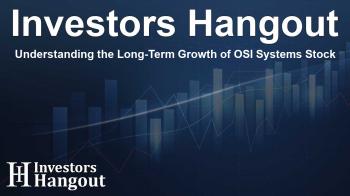Understanding the Long-Term Growth of OSI Systems Stock

OSI Systems: An Overview of 20 Years of Investment Growth
Over the past two decades, OSI Systems (NASDAQ: OSIS) has consistently outperformed the wider market, achieving an impressive annualized return of 13.26%. This performance not only places OSI Systems in a favorable light among investors but also emphasizes the importance of understanding market movements and making informed financial decisions.
Starting Investment in OSI Systems
If an investor had decided to invest $1000 in OSIS stock 20 years ago, that investment would have burgeoned to a noteworthy value of approximately $12,326.19 today. This significant growth can be attributed to the stock's overall performance and its resilience throughout varying market conditions.
Analyzing the Performance
The long-term performance of OSI Systems can be dissected through various financial metrics and market circumstances. The market capitalization currently sits at an impressive $3.57 billion, reflecting the company's robust business model and strategic innovation over the years.
The Power of Compounding Returns
One of the key insights from OSI Systems' historical performance is the profound impact of compounded returns. Understanding how reinvesting can amplify wealth over time is crucial for investors looking to maximize their potential gains. This compounding effect highlights the value of patience and strategic investment over sheer trading frequency.
Strategic Innovations Fueling Growth
OSI Systems has bolstered its growth trajectory through strategic innovations and tapping into emerging market trends. By focusing on advanced technologies and catering to evolving customer needs, the company has remained competitive and relevant. This adaptability is essential in a fast-paced technology-driven market.
Continued Investor Interest
The sustained investor interest in OSI Systems underlines the company's potential for future growth. As the market continues to evolve, OSI is well-positioned to harness new opportunities arising from technological advancements. Investors are encouraged to keep an eye on the company’s developments and incorporate them into their broader investment strategies.
Frequently Asked Questions
What is the annualized return of OSI Systems over the past 20 years?
The annualized return has been approximately 13.26%, showcasing the company’s resilience in the market.
If I had invested $1000 in OSI stock two decades ago, what would it be worth today?
That investment would be valued at approximately $12,326.19 today, indicative of substantial growth.
What is the current market capitalization of OSI Systems?
The market capitalization currently stands at about $3.57 billion, reflecting the company’s robust standing.
Why are compounded returns important for investors?
Compounded returns significantly enhance investment growth over time, emphasizing the value of long-term investment strategies.
What factors have contributed to OSI Systems' growth?
Factors include strategic innovations, adaptability to market changes, and a focus on advanced technologies.
About The Author
Contact Hannah Lewis privately here. Or send an email with ATTN: Hannah Lewis as the subject to contact@investorshangout.com.
About Investors Hangout
Investors Hangout is a leading online stock forum for financial discussion and learning, offering a wide range of free tools and resources. It draws in traders of all levels, who exchange market knowledge, investigate trading tactics, and keep an eye on industry developments in real time. Featuring financial articles, stock message boards, quotes, charts, company profiles, and live news updates. Through cooperative learning and a wealth of informational resources, it helps users from novices creating their first portfolios to experts honing their techniques. Join Investors Hangout today: https://investorshangout.com/
The content of this article is based on factual, publicly available information and does not represent legal, financial, or investment advice. Investors Hangout does not offer financial advice, and the author is not a licensed financial advisor. Consult a qualified advisor before making any financial or investment decisions based on this article. This article should not be considered advice to purchase, sell, or hold any securities or other investments. If any of the material provided here is inaccurate, please contact us for corrections.

